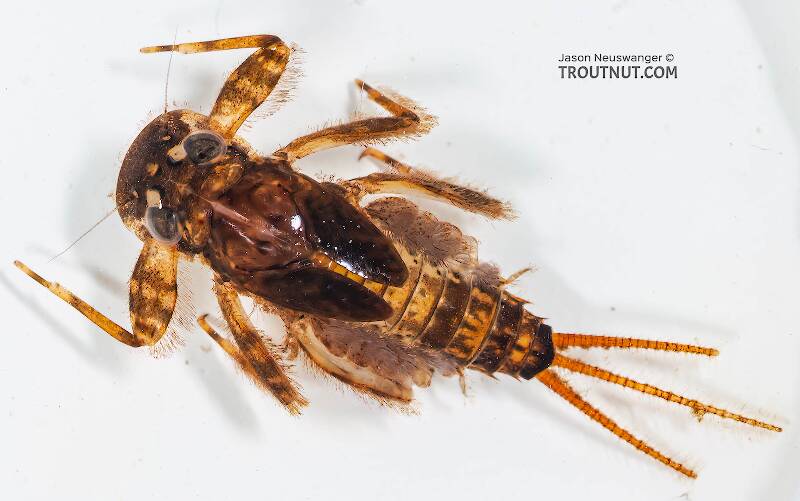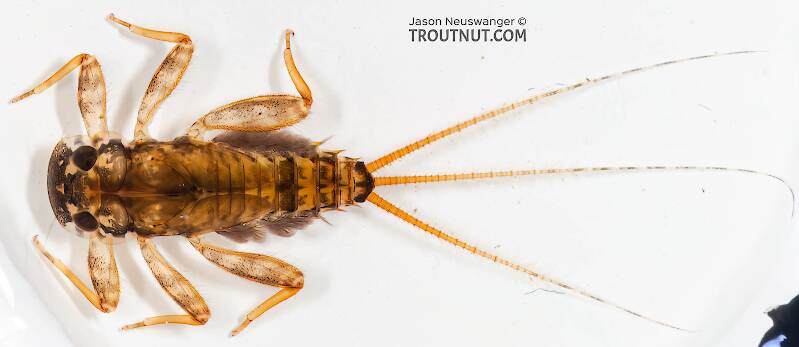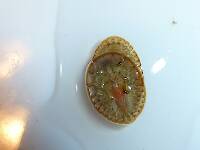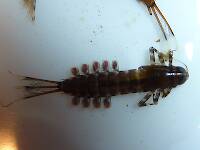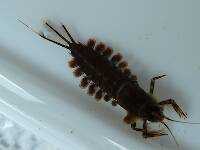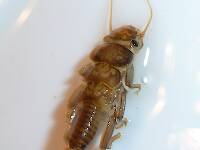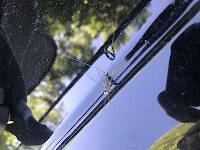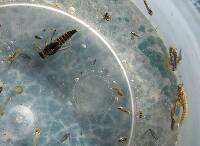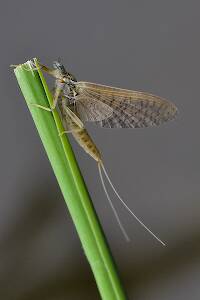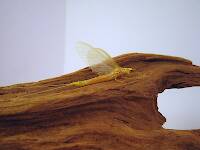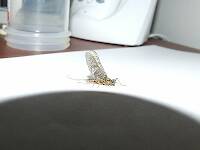
Salmonflies
Pteronarcys californica
The giant Salmonflies of the Western mountains are legendary for their proclivity to elicit consistent dry-fly action and ferocious strikes.
Featured on the forum

As far as I can tell, this species has only previously been reported from one site in Oregon along the Columbia gorge. However, the key characteristics are fairly unmistakable in all except for one minor detail:
— 4 small yellow spots on frons visible in photos
— Narrow occipital spinule row curves forward (but doesn’t quite meet on stem of ecdysial suture, as it's supposed to in this species)
— Short spinules on anterior margin of front legs
— Short rposterior row of blunt spinules on abdominal tergae, rather than elongated spinules dorsally
I caught several of these mature nymphs in the fishless, tiny headwaters of a creek high in the Wenatchee Mountains.
— 4 small yellow spots on frons visible in photos
— Narrow occipital spinule row curves forward (but doesn’t quite meet on stem of ecdysial suture, as it's supposed to in this species)
— Short spinules on anterior margin of front legs
— Short rposterior row of blunt spinules on abdominal tergae, rather than elongated spinules dorsally
I caught several of these mature nymphs in the fishless, tiny headwaters of a creek high in the Wenatchee Mountains.

Troutnut is a project started in 2003 by salmonid ecologist Jason "Troutnut" Neuswanger to help anglers and
fly tyers unabashedly embrace the entomological side of the sport. Learn more about Troutnut or
support the project for an enhanced experience here.
This topic is about the Mayfly Species Stenonema mediopunctatum
I have seen no mention of this species as a fishable hatch in angling literature, but it is noteworthy for the unusual coloration of the male spinners, which Malcolm and Knopp describe in Mayflies: An Angler's Study of Trout Water Ephemeroptera :...the male only exhibits this coloration on segments eight to ten, against an otherwise whitish to translucent body.
Example specimens
GONZO on Sep 1, 2012September 1st, 2012, 11:39 am EDT
Hi Jason,
In this section, the Midwestern nymphs (#573 & #574) with the dark irregular ventral bars across the anterior portion of the sternites look like Maccaffertium mediopunctatum arwini (the Midwestern ssp.), but the two Eastern duns (#733 & #765) and the associated shuck (of #765) and nymph (#764) look more like Maccaffertium ithaca to me.
Three Maccaffertium species can have very similar ventral markings in the nymph—dark, sinuate, chevron-shaped bars on many of the sternites and dark lateral marks (sometimes connected to form an inverted U-shaped mark) on segment 9. The Eastern mediopunctatum subspecies, M. m. mediopunctatum, has these markings, as does M. ithaca. Similar markings also appear as a less-common variant marking of M. modestum (or the M. modestum species complex). However, these species differ in the length and location of posterolateral projections, leg markings, the appearance of the subs and adults, and size.
Although interpretation of posterolateral projections can be tricky, those projections should help to separate the nymph (and husk) from mediopunctatum. On mediopunctatum, projections are usually on segments 3-9, 4-9, or 5-9, and those on 8 and 9 are fairly long. On ithaca, projections are usually on segments 6-9 or 7-9, and those on 8 and 9 are somewhat shorter (when compared to mediopunctatum). The twin brown bands on the femora of the nymphs should also help to separate them from modestum and mediopunctatum (usually three or four in those species).
The brown posterior margins and median dorsal stripes of the duns (similar to those found in M. vicarium) are typical of ithaca. In McDunnough’s original description of mediopunctatum (1926), he mentions that some of his (paratype) specimens were reared from subimagos, and he describes those subimagos as “quite pale whitish in coloration.”
Size might also be somewhat helpful in distinguishing these specimens from M. m. mediopunctatum (about 7-10 mm at maturity) and modestum (about 8-11 mm at maturity). M. ithaca is about 9-14 mm at maturity. The relatively mature nymph (#764) is at least 11 mm, the female dun (#733) is about 13 mm, and the male dun (#765) is about 11 mm.
When all of these factors are considered, it seems to me that M. ithaca is a more likely ID for the Eastern specimens. (See Bednarik and McCafferty 1979 and Lewis 1974.) I would suggest the following placement for specimens currently in this section:
M. ithaca nymph: http://www.troutnut.com/specimen/764
M. ithaca female dun: http://www.troutnut.com/specimen/733
M. ithaca male dun: http://www.troutnut.com/specimen/765
M. mediopunctatum arwini nymph: http://www.troutnut.com/specimen/573
M. mediopunctatum arwini nymph: http://www.troutnut.com/specimen/574
Best,
Lloyd
In this section, the Midwestern nymphs (#573 & #574) with the dark irregular ventral bars across the anterior portion of the sternites look like Maccaffertium mediopunctatum arwini (the Midwestern ssp.), but the two Eastern duns (#733 & #765) and the associated shuck (of #765) and nymph (#764) look more like Maccaffertium ithaca to me.
Three Maccaffertium species can have very similar ventral markings in the nymph—dark, sinuate, chevron-shaped bars on many of the sternites and dark lateral marks (sometimes connected to form an inverted U-shaped mark) on segment 9. The Eastern mediopunctatum subspecies, M. m. mediopunctatum, has these markings, as does M. ithaca. Similar markings also appear as a less-common variant marking of M. modestum (or the M. modestum species complex). However, these species differ in the length and location of posterolateral projections, leg markings, the appearance of the subs and adults, and size.
Although interpretation of posterolateral projections can be tricky, those projections should help to separate the nymph (and husk) from mediopunctatum. On mediopunctatum, projections are usually on segments 3-9, 4-9, or 5-9, and those on 8 and 9 are fairly long. On ithaca, projections are usually on segments 6-9 or 7-9, and those on 8 and 9 are somewhat shorter (when compared to mediopunctatum). The twin brown bands on the femora of the nymphs should also help to separate them from modestum and mediopunctatum (usually three or four in those species).
The brown posterior margins and median dorsal stripes of the duns (similar to those found in M. vicarium) are typical of ithaca. In McDunnough’s original description of mediopunctatum (1926), he mentions that some of his (paratype) specimens were reared from subimagos, and he describes those subimagos as “quite pale whitish in coloration.”
Size might also be somewhat helpful in distinguishing these specimens from M. m. mediopunctatum (about 7-10 mm at maturity) and modestum (about 8-11 mm at maturity). M. ithaca is about 9-14 mm at maturity. The relatively mature nymph (#764) is at least 11 mm, the female dun (#733) is about 13 mm, and the male dun (#765) is about 11 mm.
When all of these factors are considered, it seems to me that M. ithaca is a more likely ID for the Eastern specimens. (See Bednarik and McCafferty 1979 and Lewis 1974.) I would suggest the following placement for specimens currently in this section:
M. ithaca nymph: http://www.troutnut.com/specimen/764
M. ithaca female dun: http://www.troutnut.com/specimen/733
M. ithaca male dun: http://www.troutnut.com/specimen/765
M. mediopunctatum arwini nymph: http://www.troutnut.com/specimen/573
M. mediopunctatum arwini nymph: http://www.troutnut.com/specimen/574
Best,
Lloyd
Troutnut on Sep 2, 2012September 2nd, 2012, 11:54 pm EDT
Thanks for the detailed rationale, Lloyd! I moved those three to ithaca.
Jason Neuswanger, Ph.D.
Troutnut and salmonid ecologist
Troutnut and salmonid ecologist
GONZO on Sep 3, 2012September 3rd, 2012, 9:34 am EDT
My pleasure, Jason. While on the subject of M. ithaca, I also noticed this male dun in the M. terminatum section that I suspect is probably another example of M. ithaca:
http://www.troutnut.com/specimen/780
Despite its coincidence with good examples of male and female terminatum adults, the overall appearance of this specimen is a good match for ithaca (cf. #733 and #765 above). Although there can be some dark-to-light variation in the subs/adults of the Eastern terminatum subspecies, I don't think they ever have the mid-dorsal stripes. When dorsal markings are apparent in darker terminatum duns, they usually consist of of a narrow band across the posterior margin of the terga or some suggestion of the twin sublateral dashes representative of the "bipunctatum" synonym. The femoral banding of M. terminatum subs/adults usually tends to fade into obsolescence on the rear legs, and they often have pale whitish unmarked (or faintly marked) tails. Although both of the following examples are of pale Western (female) terminatum duns, they show these (leg/tail) tendencies:
http://www.troutnut.com/specimen/886
http://bugguide.net/node/view/685336/bgimage
In addition, the eye separation in the male dun that I am proposing for ithaca (#780) is close to the width of the lateral ocellus while the separation of the male terminatum imago (http://www.troutnut.com/specimen/777) is considerably wider (which is typical of that species). I suspect that the the eye spacing on the dun will probably close slightly upon molting to the imago, but I don't think that space would ever widen.
http://www.troutnut.com/specimen/780
Despite its coincidence with good examples of male and female terminatum adults, the overall appearance of this specimen is a good match for ithaca (cf. #733 and #765 above). Although there can be some dark-to-light variation in the subs/adults of the Eastern terminatum subspecies, I don't think they ever have the mid-dorsal stripes. When dorsal markings are apparent in darker terminatum duns, they usually consist of of a narrow band across the posterior margin of the terga or some suggestion of the twin sublateral dashes representative of the "bipunctatum" synonym. The femoral banding of M. terminatum subs/adults usually tends to fade into obsolescence on the rear legs, and they often have pale whitish unmarked (or faintly marked) tails. Although both of the following examples are of pale Western (female) terminatum duns, they show these (leg/tail) tendencies:
http://www.troutnut.com/specimen/886
http://bugguide.net/node/view/685336/bgimage
In addition, the eye separation in the male dun that I am proposing for ithaca (#780) is close to the width of the lateral ocellus while the separation of the male terminatum imago (http://www.troutnut.com/specimen/777) is considerably wider (which is typical of that species). I suspect that the the eye spacing on the dun will probably close slightly upon molting to the imago, but I don't think that space would ever widen.
Entoman on Sep 4, 2012September 4th, 2012, 6:42 pm EDT
Thanks for the detailed analysis, Gonzo. VERY helpful for future reference.
"It's not that I find fishing so important, it's just that I find all other endeavors of Man equally unimportant... And not nearly as much fun!" Robert Traver, Anatomy of a Fisherman
Quick Reply
Related Discussions
Topic
Replies
Last Reply
13
Sep 14, 2011
by Jmd123
by Jmd123


